Yves GARY Hits: 3967
Category: 1903 : CHALLENGE N°12
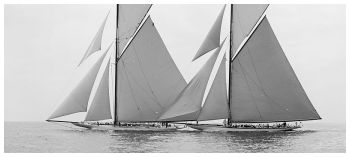 VICTORY BY SMALL MARGIN
VICTORY BY SMALL MARGIN Aug. 26, 1903 - Reliance and Shamrock III, sailed their second race yesterday, and Reliance won her second victory.
Aug. 26, 1903 - Reliance and Shamrock III, sailed their second race yesterday, and Reliance won her second victory.
For the challenger's defeat no shift of wind or unseen current can be held responsible. It was a fair race sailed over a clear course, and the defender's victory has knocked another prop from under the pedestal which holds up Sir Thomas Lipton's hope of winning the cup this year.
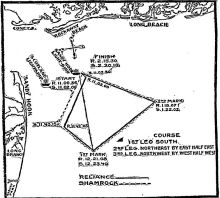 THE RACE IN DETAIL
THE RACE IN DETAILThough outmaneuvered at the start and forced to make a stern chase over the course, Shamrock III. sailed a splendid race and held the Reliance surprisingly both on and off the wind. The conditions of wind and water suited her exactly and she did very much better than on Saturday. There was scarcely any ground swell and only a little bobble, though not enough to be dignified by the name of chop. The wind was rather light at the start, probably about five miles an hour, but, gaining strength soon after the start, it rose to about twelve miles when the yachts turned the first mark. It softened again somewhat as they neared the finish, but did not fall below eight. There was a slight shift to the westward after the first mark was raised, and another shift to the southward on the latter half of the last leg.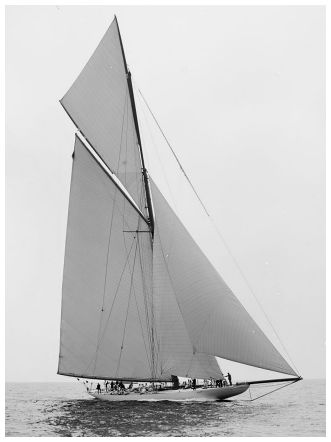
The course was triangular, the first leg being laid south, to windward; the second, northeast by east half-east; the third, northwest by west half-west. The second leg should have been a broad reach with booms off on the port side, but it was mostly a run with spinnakers. The third leg was a close reach to the finish, so close for the first half that the yachts were actually on the wind.
The preparatory signal was given promptly at 10:55. The committee boat Navigator was then anchored about a quarter of a mile due west of the Sandy Hook Lightship. Reliance was then close to the committee boat, standing eastward with her boom off to port. Half a mile ahead of her was the Shamrock, also standing to the eastward.
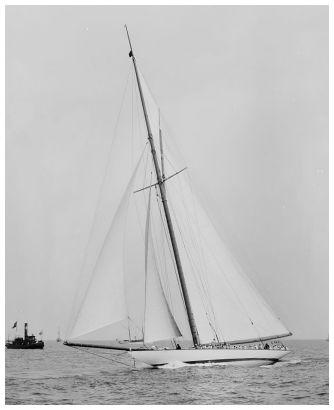 Reliance carried her largest club topsail over the ordinary working sails and had a baby jibtopsail up in stops. The club topsail of Shamrock was noticeably smaller than that of Reliance. Shamrock also had a baby jibtopsail up in stops.
Reliance carried her largest club topsail over the ordinary working sails and had a baby jibtopsail up in stops. The club topsail of Shamrock was noticeably smaller than that of Reliance. Shamrock also had a baby jibtopsail up in stops.
Soon after the preparatory signal Shamrock went about and stood back toward the lightship. She passed to leeward of the red hulk and stood on northward of the line toward the committee boat. Reliance, as Shamrock approached, also went about and stood back ahead and to windward. She passed to windward of the lightship. Thus the rivals stood westward parallel with the line, one above and the other below it. Barr was carefully laying his plans to take and hold the windward berth.
After passing the lightship, Barr bore away and ran down on the weather bow of Shamrock, then hauled up and continued in the lead. That maneuver somewhat deadened her headway and Shamrock, having a better pace, reached madly through her lee. But before she could get through, Barr sent Reliance ahead and kept her on the challenger’s weather quarter. At 10:53, when the warning signal was only two minutes away, both yachts were thrown up in the wind until their head sails shook. Thus they stood for some seconds like impatient chargers shaking their manes. Shamrock was the first to pay off and Reliance quickly followed.
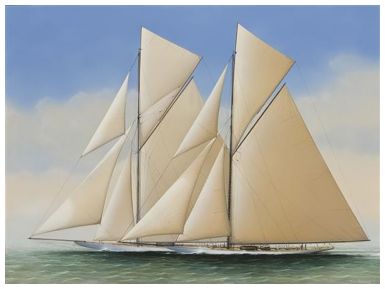 At 10:54:15 Shamrock suddenly swung off her course, wore ship and stood to the eastward. Barr turned Reliance in the same manner, thus keeping her on Shamrock’s weather quarter. At the warning signal, 10:55, they were in those relative positions, perhaps 200 yards to the westward and southwest of the committee boat. They held on to the eastward parallel with the line. At 11:02, three minutes before the time for the starting signal, they bore away to the northward, passing close to the lightship. Shamrock tacked to the eastward of that mark and Reliance to the westward of it, and both stood back toward the committee boat. Reliance was then on Shamrock’s weather bow instead of weather quarter.
At 10:54:15 Shamrock suddenly swung off her course, wore ship and stood to the eastward. Barr turned Reliance in the same manner, thus keeping her on Shamrock’s weather quarter. At the warning signal, 10:55, they were in those relative positions, perhaps 200 yards to the westward and southwest of the committee boat. They held on to the eastward parallel with the line. At 11:02, three minutes before the time for the starting signal, they bore away to the northward, passing close to the lightship. Shamrock tacked to the eastward of that mark and Reliance to the westward of it, and both stood back toward the committee boat. Reliance was then on Shamrock’s weather bow instead of weather quarter.
Wringe aimed to get as close to the windward end of the line as possible, while Barr, to avoid being crowded, laid his course southward of the committee boat and at the same time allowed Shamrock to come up abreast of him. At 10:59:35 he suddenly wore ship and slipped in between Shamrock and the committee boat. Then he was in position to haul up sharp on the wind and cross on the starboard tack immediately after the signal. It was a very clever plan neatly executed. Wringe being at a disadvantage, had to choose between crossing the line under his adversary’s lee or standing further westward until he could get a clear course. 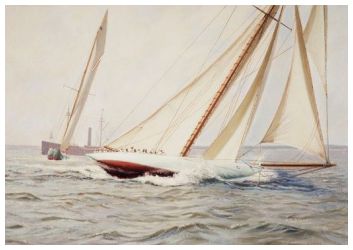 He chose the latter alternative, but he miscalculated his time and did not turn soon enough, so when he crossed the line he was handicapped 19 seconds.
He chose the latter alternative, but he miscalculated his time and did not turn soon enough, so when he crossed the line he was handicapped 19 seconds.
Reliance had crossed on the starboard tack and Shamrock also crossed on that tack as close to the committee boat as she could well go, but once clear of the Navigator she went on the port tack. She was so close that the smoke of the handicap gun formed a halo around her club topsail.
The Reliance, more than a quarter of a mile away, went on the port tack at 11:02 coincidently with the handicap gun. Barr's object was to cross the Shamrock’s bows and put Reliance in the windward position. Wringe‘s move foiled his design. Nevertheless Reliance held the better position.
And now the race was fairly on. The admirers of Reliance expected to see her walk right away from the Shamrock as she did on Saturday, 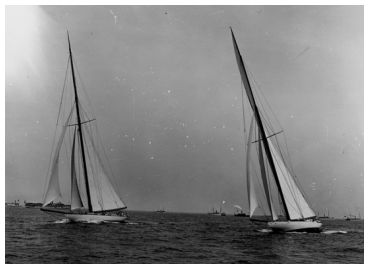 but they were disappointed. True, she had to make a stern chase, but she made it well, and incidentally forced the defender to hustle.
but they were disappointed. True, she had to make a stern chase, but she made it well, and incidentally forced the defender to hustle.
The wind freshened until the bubble of sea became almost choppy and plentifully crested with whitecaps. The yachts heeled until their lee rails were well awash, and they went through the water, sending showers of spray over the bows and leaving broad trails of foam behind at a pace that strained the steamers to hold it. Reliance went to the front and to windward, but she went slowly. Shamrock was sailing a beautiful race and doing extremely well. So the race went for the first half hour.
On the port tack the yachts were standing in toward the Jersey coast, raising the twin Highland lights into plain view and even the outlines of the larger buildings at Seabright. Reliance held the port tack exactly forty-two minutes and five seconds. At 11:42:05 she went to starboard. It could not then be accurately discerned how much she had increased her lead. Shamrock held the port tack until 11:43:10. As she went about it was seen that the Reliance was less than three-quarters of a mile ahead.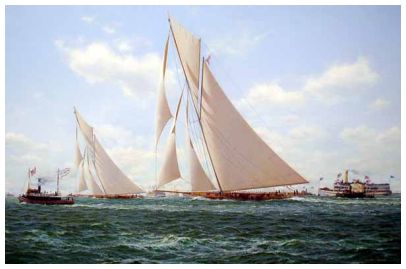
Up to this time the wind had held steady, and it remained so for more than 20 minutes longer. At 12:10, however, it suddenly hauled more to the westward and enabled both yachts to lay their course for the first mark with slightly lifted sheets. Reliance being ahead got the shift first, and when she eased her sheets many spectators erroneously supposed that something had parted or gone wrong. In less than half a minute Shamrock got the shift also and on the whole was the more benefited by it. At 12:16 Reliance took in her jibtopsail preparatory to rounding, and two minutes later Shamrock followed suit. Thus, notwithstanding the stern chase the racers were still pretty close together.
So they were only two minutes and thirty-two seconds apart. Reliance had gained one minute and eight seconds, according to the official time of the start, but only forty-nine seconds in actual time. Compared with her loss of three minutes and twenty-one seconds in the fifteen-mile beat in Saturday's race, this was doing astonishingly well.
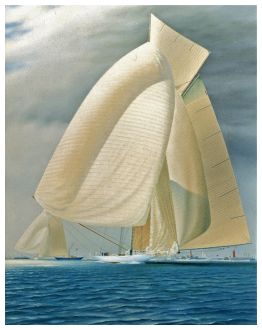 On rounding the mark booms were eased broad off to port, and the light sails were sent up. Reliance broke out her jib topsail in less than thirty seconds, but it was a No. reacher instead of a balloon. The Shamrock’s crew was even more expeditious. They broke out a balloon jibtopsail in less than fifteen seconds and the balloon jibtopsail proved to be the proper sail. Barr had subsequently to admit that by taking in his reacher and setting a balloon. He carried the reacher less than five minutes. At 1:27 he broke out the balloon.
On rounding the mark booms were eased broad off to port, and the light sails were sent up. Reliance broke out her jib topsail in less than thirty seconds, but it was a No. reacher instead of a balloon. The Shamrock’s crew was even more expeditious. They broke out a balloon jibtopsail in less than fifteen seconds and the balloon jibtopsail proved to be the proper sail. Barr had subsequently to admit that by taking in his reacher and setting a balloon. He carried the reacher less than five minutes. At 1:27 he broke out the balloon.
At first the Shamrock doused both jib and staysail, but about four minutes after rounding she reset the staysail. Both skippers soon discovered that they could carry spinnakers to advantage. Barr sent out his pole to starboard at 12:36, and broke out the sail at 12:37. Shamrock's spinnaker was a minute and a half later in making its appearance. Never did spinnakers draw better for about fifteen minutes. At 12:00 the wind hauled more to the westward, and the Reliance took her spinnaker in. Shamrock, however, carried hers about seven minutes longer. In the meanwhile both skippers alternately took in and reset staysails, but finally Shamrock settled down to a ballooner, while Reliance contented herself with a working staysail. The larger sail undoubtedly helped the challenger.
And now another surprise began to break on the friends of the defender. Although Shamrock had held on well in the windward work, they were certain Reliance would run away from her off the wind. But Shamrock held on as if she had a towline. Reliance drew ahead somewhat, but she could not get away.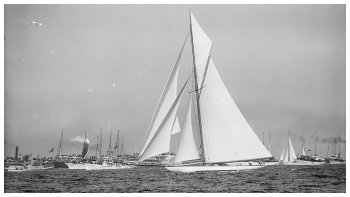
Here is the way in which they turned the second mark: Reliance, 1:17:43; Shamrock III, 1:21:40.
Two legs of the course had been covered, and still they were only 03.55 apart. Reliance had gained only 01.23 off the wind on the second leg. Her friends expected her to gain at least three minutes.
It was now a close reach home, so close that the yachts for at least six miles were pratically on the wind. All the time Reliance was sailing that distance she carried a baby jibtopsail aloft in stops, but Capt. Barr did not see fit to break it out. The wind was too fresh, and the boat was pointing too close in its eye. Barr had made another slight mistake in rounding the second mark. He had held on to his balloon jibtopsail with the evident intention of carrying it on the last leg, but it would not work. 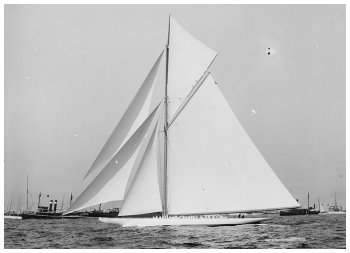 After trying it for nearly three minutes while it hampered the boat seriously he took it in. Shamrock took in her balloon as she neared the mark and broke out a baby less than two minutes after rounding. She benefited materially by superior handling of her sails at this stage of the race. But for all that, she could not catch up. At 1:52, the wind having backed again to the southward, Reliance broke out her baby jibtopsail and carried it for about 15 minutes. Then the babies came down almost together on both yachts. At 2:08 Reliance broke out a No. 3, while a minute later Shamr0ck broke out a No. 1 reaching jibtopsail two sizes larger than the one Reliance carried. Under these sails they finished one of the most beautiful and stubbornly contested races ever sailed for the cup.
After trying it for nearly three minutes while it hampered the boat seriously he took it in. Shamrock took in her balloon as she neared the mark and broke out a baby less than two minutes after rounding. She benefited materially by superior handling of her sails at this stage of the race. But for all that, she could not catch up. At 1:52, the wind having backed again to the southward, Reliance broke out her baby jibtopsail and carried it for about 15 minutes. Then the babies came down almost together on both yachts. At 2:08 Reliance broke out a No. 3, while a minute later Shamr0ck broke out a No. 1 reaching jibtopsail two sizes larger than the one Reliance carried. Under these sails they finished one of the most beautiful and stubbornly contested races ever sailed for the cup.
Here are the times of the finish and the elapsed times for the third leg:
They were separated in time by only 4:40, and the Reliance had gained only 40 seconds on the 10-knot reach, her strongest point of sailing. Everyone was disposed to say and say cheerfully: “Well done Shamrock."

Reliance wins by 3 minutes 16 seconds elapsed time and 1 minute 19 seconds corrected time.
Reliance gains : 1:08 in the first leg, 1:23 in the second leg, 0:45 in the third leg.

